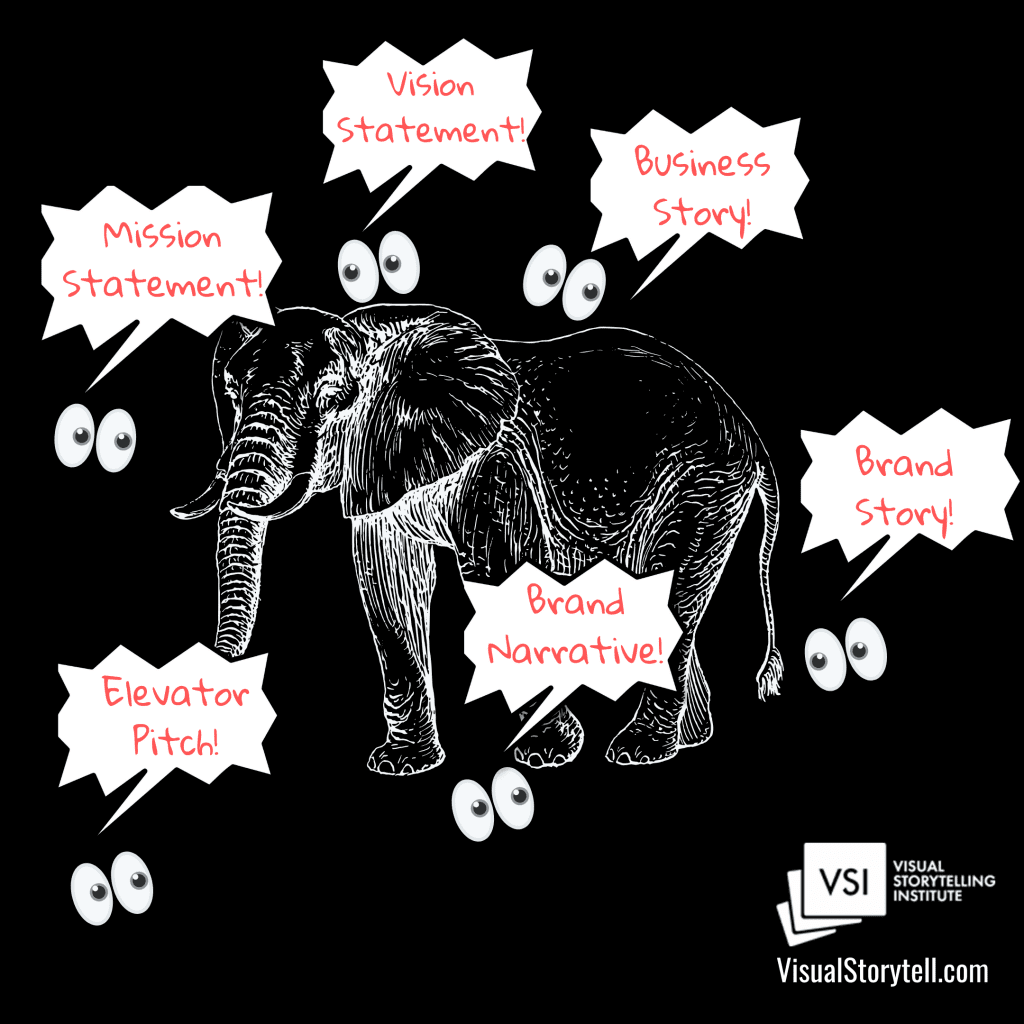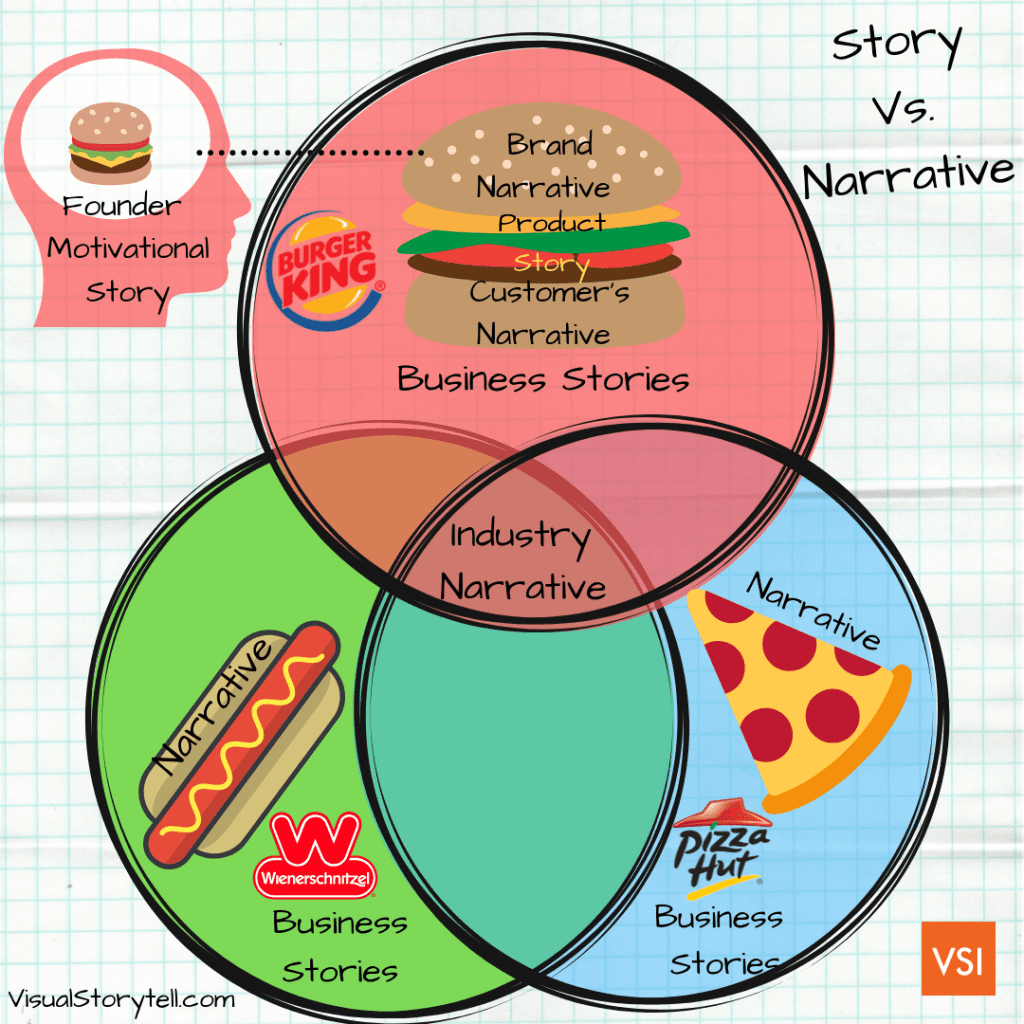
What’s the Difference Between a Story and a Narrative?
What’s the Difference Between a Story and a Narrative? https://www.visualstorytell.com/wp-content/uploads/2019/06/story_vs_narrative_thumb.jpg 370 218 Shlomi Ron Shlomi Ron https://secure.gravatar.com/avatar/995c0cf093380b90c7704fda398c9addf4e5c605afbc92af5c3f01f67d65aa41?s=96&d=mm&r=g
Do you know what is the difference between a Story and a Narrative?
In my client workshops and reading content online, I see people use them interchangeably, which is incorrect. So, let’s unpack this with the right definitions.
 My rendition of the Blind Men and the Elephant fable to marketing terms
My rendition of the Blind Men and the Elephant fable to marketing terms
Your Brand Narrative is the answer to Why you do what you do. It’s not about the What and How. As Simon Sinek aptly coined:“People don’t buy what you do. They buy why you do it.”
I like GoNarrative’s further categorization of 3 narrative types:
Brand Narrative that relates to a specific product or division within a larger company.
Master Narrative that defines the company’s narrative.
Meta Narrative is shaped around cultural norms and belief systems. “There are meta narratives of success and failure; cultural and technological shifts; individuals and communities. These metanarratives always have a moral lesson associated with them: What’s right, or wrong about the world? (source: GoNarrative)”
A great Brand narrative resonates with both customers’ stories the Master Narrative of the company and a larger moral coming from the Meta Narrative.
Consider these narrative examples:
Patagonia: “We’re in business to save our home planet.”
Coca Cola: “The Coca-Cola Company is to refresh the world in mind, body, and spirit, and inspire moments of optimism; to create value and make a difference.”
And closer to home, the Visual Storytelling Institute: “We’re in the ”noise cancelling business” helping leaders rise above the communication noise and achieve total acuity - one visual story at a time.”
Your Business Stories serve as proof points that support your larger Business Narrative with showing vs. telling your What and How. As such, stories follow the three-act story structure (i.e., Setting, Conflict, and Resolution).
Whereas, a Narrative is all about describing the larger emotional vision or purpose of your brand. Your narrative is embedded into the entire DNA of your business culture and is what sets you apart from your competitors. In this sense, your narrative shapes your prospects and customers’ perceptions.
To tie it all together I like Michael Margolis metaphor who says:
“If stories are each like a pearl, then a narrative is the necklace or string of pearls. It’s what connects the dots at the big picture level. A good narrative will use a range of stories to illustrate, animate, and validate its message.”
Time-wise, narratives describe what’s possible in the future whereas stories represent past events about locations, characters, conflicts, and resolutions.
Now that we’ve got the basics down, it’s important to realize that there are key business narratives and stories you should be familiar with:
 Stories and narratives every business leader should go to battle with.
Stories and narratives every business leader should go to battle with.
Motivational Story: This is literally the story you tell yourself why you get up every morning, all jazzed up to do the best work you can do.
Brand Narrative: Your overarching purpose that frames your emotional big WHY or the unique experience of doing business with you.
Customer Narrative: It’s the narrative your customer tells herself about the problem category your product/service can solve. This narrative is formed by individual past experiences=stories.
Product Story: Metaphorically speaking, if your Business Narrative and your Customer’s Narrative are two slices of a hamburger bun, your Solution Story is the actual “meat” that connects your purpose with your customer’s problem. This story provides the How & What and offers clear rewards.
Business Story: These are proof points that support your larger Business Narrative across channels and stages of your buyer’s journey. Business stories bring to life events from your employees, your customers, partners or vendors.
Competitor Narrative: Mirror image of your Business Narrative. It describes the business purpose of your competitor.
Competitor Business Stories: Proof points that support your competitor’s business narrative. Like your business stories, you’ll find your competitor’s business stories competing with yours across channels and stages of your competitor’s buyer’s journey.
Industry Narrative: The overarching norms and belief systems that govern your industry.
How are you using stories and narratives in your business? Feel free to Book a conversation if you need help.
- Post Tags:
- story vs. narrative
- visual storytelling
- Posted In:
- Story Making
- Story Telling
- Visual Storytelling
Shlomi Ron
Shlomi Ron is the founder and CEO of the Visual Storytelling Institute, a Miami-based think tank with a mission to bring the gospel of visual storytelling from the world of art to more human-centric and purpose-driven marketing. A digital marketing veteran with over 20 years of experience working both on the agency and brand sides for Fortune 100/500 brands such as Nokia, IBM, and American Express. He started VSI to combine his marketing expertise with his passion for visual stories stemming from his interests in classic Italian cinema and managing the estate of video art pioneer, Buky Schwartz. At VSI, he helps brands rise above the communication noise through visual storytelling consulting, training, and thought leadership. Select clients include Estée Lauder, Microsoft, and Cable & Wireless – to name a few. He currently teaches Brand Storytelling at the University of Miami’s Business School. Thought leader and speaker at key marketing conferences. He is also the host of the Visual Storytelling Today podcast, which ranks in the top 10 best business storytelling podcasts on the Web. His book: Total Acuity: Tales with Marketing Morals to Help You Create Richer Visual Brand Stories. Outside work, he is a nascent bread baker, The Moth fan, and longtime fedora wearer likely to jive with his classic Italian cinema interest.
All stories by: Shlomi RonYou might also like
3 comments
This site uses Akismet to reduce spam. Learn how your comment data is processed.





Leave a Reply